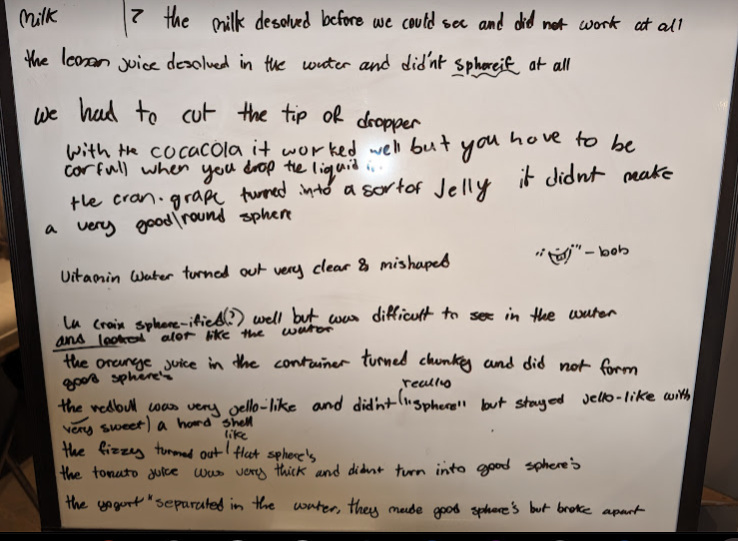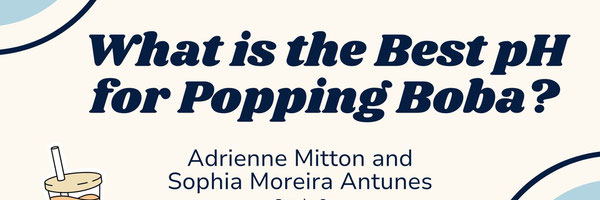Potential of Hydrogen (pH) on the Spherification of Liquids
Grade 6
Presentation
Hypothesis
A liquid with a low pH will not take a sphere-shaped form due to too much hydrogen available. A liquid with a high pH will not be ideal for spherification either because the liquid inside the sphere would become a gel too quickly due to the lack of hydrogen molecules to compete with how quickly calcium molecules will bind alginate strands together. With that information, we think that a pH of around 6-8 is the best pH for spherification because a neutral pH is 7.
Research
Sodium alginate and calcium lactate gluconate are two ingredients that are commonly used in “molecular gastronomy” for the spherification of liquids. Sodium alginate comes from algae and is what is called a “polysaccharide’’, made of chains of carbohydrates. Sodium alginate is mixed into a flavoured liquid. Calcium lactate gluconate powder is added to water to create a bath to drop the sodium alginate mixture into. When the flavoured liquid droplets hit the calcium bath the calcium particles replace the sodium particles and link the alginate polysaccharide chains together. This is what forms the gel like encasing around the sphere.
Different conditions can affect how well spherification works including the pH of the flavoured liquid, temperature, the distance at which you drop the flavoured liquid from and how much calcium lactate gluconate powder or sodium alginate powder you put into your liquids or bath.
pH stands for “potential of hydrogen”. The lower the pH of a liquid, the more hydrogen it contains. Hydrogen is more reactive than calcium and is quick to replace sodium in the sodium alginate strands. Calcium therefore does not have a chance to link the polysaccharide strands together, causing the strands to stay flexible and no gel to form.
Variables
controlled: Height of which the liquid is dropped, size of droppers, temperature of liquids, amount of sodium alginate, amount of calcium lactate gluconate, amount of water used, and amount of liquids used in each trial.
manipulated: pHs of the various liquids we used.
responding: if proper spheres formed.
Procedure
1. Test the pH of your liquid of choice with a pH strip and note the pH within 30 seconds of testing.
2. Weigh 100g of your liquid and 0.5g of sodium alginate with a food scale.
3. Pour your liquid and sodium alginate into one container and blend for 2 minutes with a hand mixer.
4. If there are any bubbles that form on top of the liquid after blending, simply remove it with a spoon as it affects the formation of a sphere.
5. Weigh out 2.5g of calcium lactate gluconate powder and measure 2 cups of water.
6. Add the water and calcium lactate gluconate to a big bowl and blend with the hand mixer for 2 minutes.
7. Use a dropper and draw up your chosen liquid. Squeeze droplets of the sodium alginate liquid into the calcium lactate gluconate bath at a consistent height of 0.5 inchs above the calcium bath.
8. Observe and record for any spheres forming and use a mesh ladle to remove spheres from the bath for further observations.
9. Repeat steps 1-8 with another liquid. Run at least 3 trials for each liquid.
Observations
Our trials with the various liquids of different pHs showed that liquids with a pH of around 7 work best for spherification. Therefore, our experiment demonstrated that our hypothesis was accurate.
Analysis
| Trial One - Not Used | Trial Two | Trial Three | Trial Four | ||||||||||
| Liquid | pH | Spherification | Observations | pH | Spherification | Observations | pH | Spherification | Observations | pH | Spherification | observations | |
| Lemon Juice | 2 | N | the lemon juice desolved into the water and didnt sphereify | 3 | N | the lemon juice desolved into the water and didnt sphereify | 3 | N | the lemon juice desolved into the water and didnt sphereify | 3 | N | the lemon juice desolved into the water and didnt sphereify | |
| Orange Juice | 5 | N | the orange juice in the container turned out chunky and did not form good spheres | 5 | N | the orange juice had a thick egg yolk consistency. it didnt form good spheres and broke apart easily | 5 | N | the orange juice had a thick egg yolk consistency. it didnt form good spheres and broke apart easily | 5 | N | the orange juice had a thick egg yolk consistency. it didnt form good spheres and broke apart easily | |
| Cran-Grape Juice | 3 | N | the cran grape in the container turned into a sort of jelly and didnt make a very round sphere | 4 | N | spherified nicely in the water but popped as soon as we took them out | 3 | N | didnt pop this time but came out very flat | 4 | N | didnt pop this time but came out very flat | |
| Redbull (Sugar-Free) |
4 | N | the red bull was very jello-ey and didnt sphereify but instead just stayed as jello | 4 | N | the liquid mixture became very thick in the cup and didnt make good spheres | 4 | N | the liquid mixture became very thick in the cup and didnt make good spheres | 4 | N | the liquid mixture became very thick in the cup and didnt make good spheres | |
| Fizzy Water | 3 | Y | the fizzy spherified but the shap of it was flat | 4 | Y | spherified nicely but was difficult to see in the clear water | 4 | Y | spherified nicely but was difficult to see in the clear water | 4 | Y | spherified nicely but was difficult to see in the clear water | |
| Vitamin Water | 5 | Y | the vitamin water was clear and misshaped | 4 | Y | spherified perfectly | 5 | Y | spherified perfectly | 4 | Y | spherified perfectly | |
| Milk | 7 | N | the milk dissolved before we could see it and did not work at all | 6 | N | the milk dissolved before we could see it and did not work at all | 7 | N | the milk dissolved before we could see it and did not work at all | 7 | N | the milk dissolved before we could see it and did not work at all | |
| Greek Yogurt | 5 | N | the greek yogourt made good globs and looked like cottage cheese but broke apart and the yogourt also seperated in the water. | 5 | N | the greek yogourt made good globs and looked like cottage cheese but broke apart and the yogourt also seperated in the water. | 5 | N | the greek yogourt made good globs and looked like cottage cheese but broke apart and the yogourt also seperated in the water. | 6 | N | the greek yogourt made good globs and looked like cottage cheese but broke apart and the yogourt also seperated in the water. | |
| Coca-Cola (Zero Sugar) |
5 | Y | the coca cola worked well but you had to be careful when dropping the liquid in. | 5 | Y | spherifed nicely | 5 | Y | spherifed nicely | 5 | Y | spherifed nicely | |
| Tomato Juice | 5 | Y | the tomato juice was very thick. they did not turn into very good spheres | 5 | N | didnt spherify | 5 | N | didnt spherify | 5 | N | didnt spherify | |
| Tap Water | 7 | Y | perfect spheres | 7 | Y | perfect spheres | 7 | Y | perfect spheres | 7 | Y | perfect spheres | |
Conclusion
Our hypothesis was that low pHs would be too acidic and high pHs would be too basic for spherification. Therefore pHs between 6-8 would be the best for spherification.
Our trials with the various liquids of different pHs showed that liquids with a pH of around 7 work best for spherification. Therefore, our experiment demonstrated that our hypothesis was correct.
Application
Spherification is a technique that is used in the food industry in many ways. Some examples of where you might find spherified foods in daily life include popping boba as an ingredient in bubble tea, fancy cocktails and cake decoration. It is also a technique used to make pills, including drugs that require slow-release, probiotics and supplements to preserve their active ingredients.
Sources Of Error
In the future something we would do differently is use variables with a higher range on the pH scale like things with pHs of 11 and use more basic liquids since we didn’t have any variables with a pH above 7. This is likely because most foods and liquids suitable for human consumption do not exceed a pH of 7.
Another limitation we faced was the uncontrolled variable's in the liquids for example, the calcium in the milk effected spherificaiton poorly compared to the water which had no calcium although they both had a pH of 7.
Citations
- Ideas: https://cen.acs.org/articles/92/i42/Science-Spherification.html
- Kitchen Theory: https://kitchen-theory.com/sodium-alginate-spherification/#:~:text=Sodium%20alginate%20(a%20food%20product,a%20technique%20known%20as%20spherification
- Chemical and Engineering News: https://cen.acs.org/articles/92/i42/Science-Spherification.html
- University of Delaware: https://sites.udel.edu/k12engineering/activities/hydrogels-in-the-kitchen-hydrogels-in-the-body/#:~:text=Popping%20boba%20are%20made%20by,that%20keeps%20the%20liquid%20contained
- Science fair: https://csef.usc.edu/History/2016/Projects/36388.pdf
- Delighted Cooking: https://www.delightedcooking.com/what-is-spherification.htm
- Chanez Bennacef, Sylvie Desobry-Banon, Laurent Probst, Stéphane Desobry. Advances on alginate use for spherification to encapsulate biomolecules. Food Hydrocolloids, 2021, 118, pp.106782.ff10.1016/j.foodhyd.2021.106782ff. ffhal-03348516ff
- Transporting water: https://www.discoveryexpresskids.com/blog/spherification-and-edible-water-spheres
- https://food-hacks.wonderhowto.com/how-to/make-water-bottles-you-can-eat-0154909/
- Popping Boba: https://en.wikipedia.org/wiki/Popping_boba
- Recipe: https://www.greatbritishchefs.com/how-to-cook/how-to-spherify
- https://itschemicallydelicious.wordpress.com/2013/02/07/the-science-behind-spherification/
Acknowledgement
Natalie(Adriennes Mom)
Mrs McNeil
Mrs Marshall

